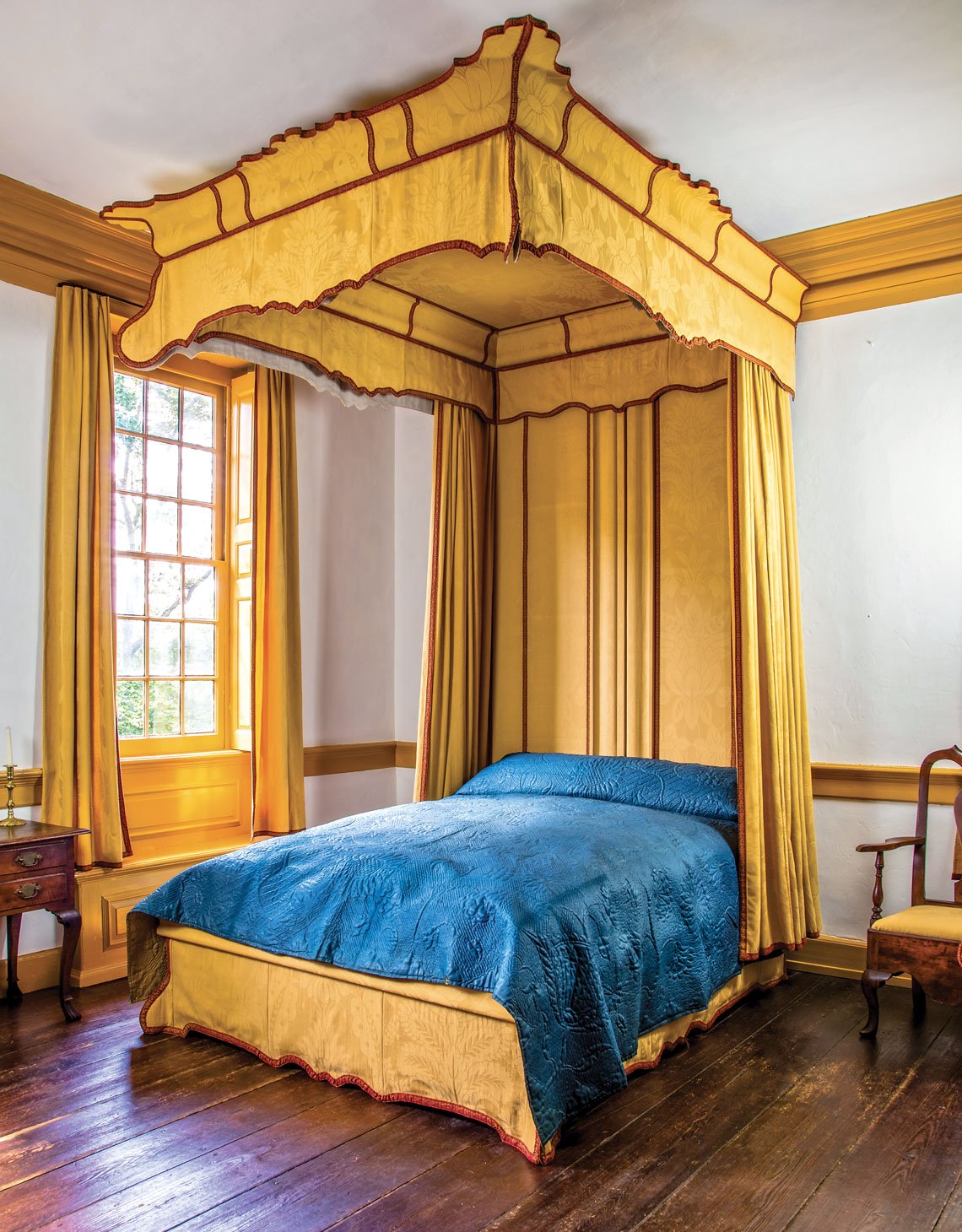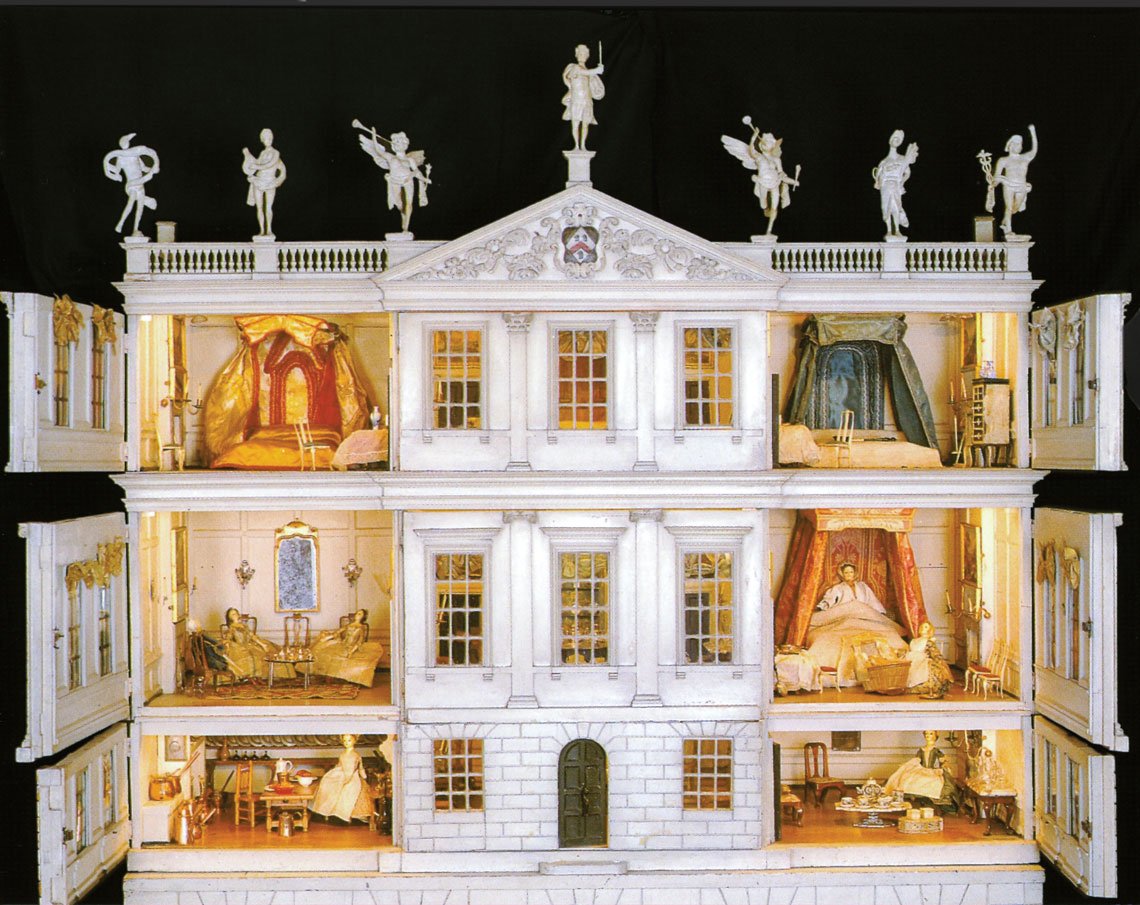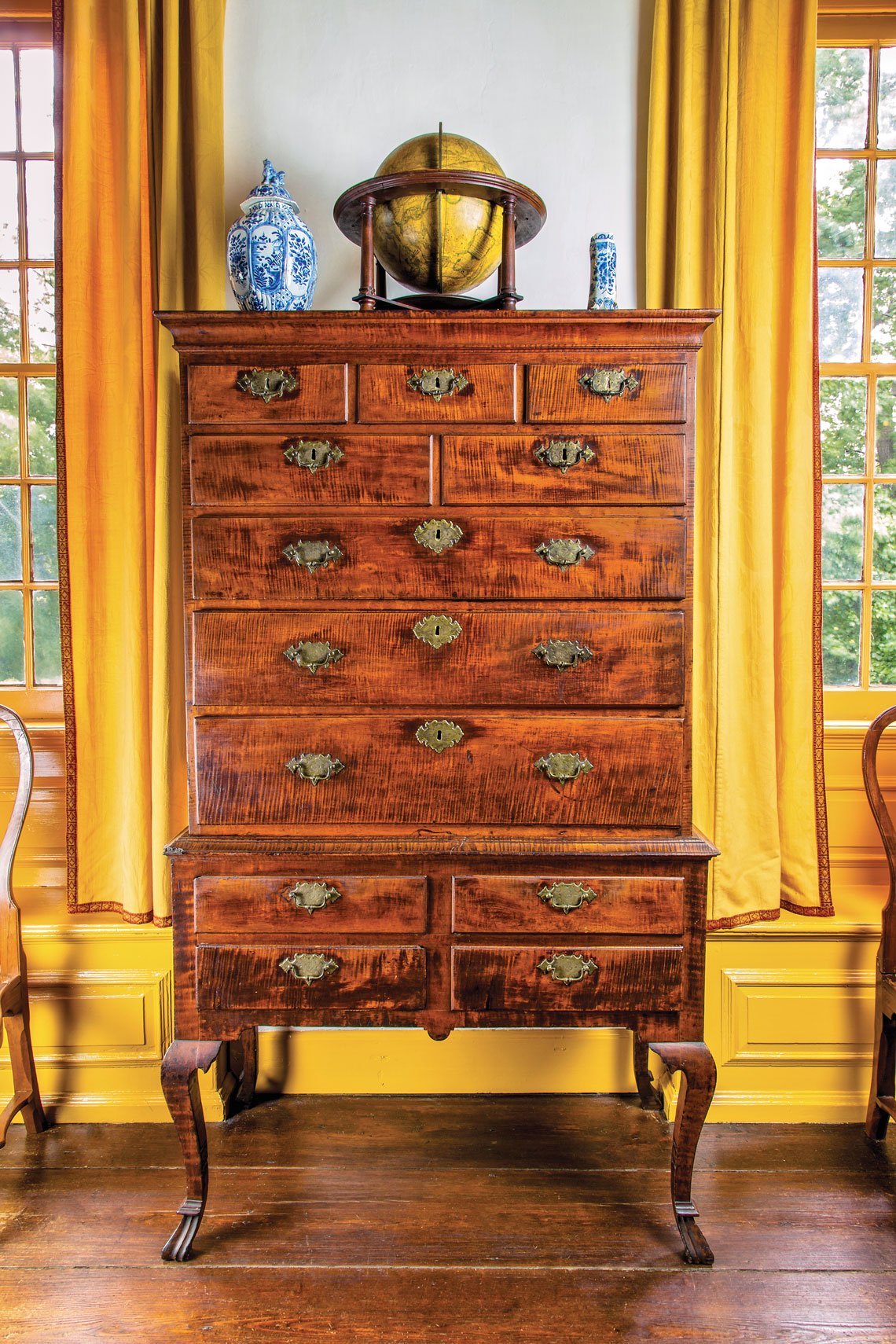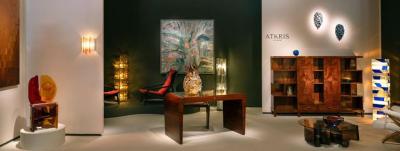The Restoration of Stenton's Yellow Lodging Room
Ochre, Old Fustic, and Maple
In 1730, James Logan (1674–1751) built a brick gentleman’s house that is today renowned for its early Georgian architecture and outstanding collections.1 Originally situated on a 511-acre plantation, five miles from the Colonial port of Philadelphia, the residence contained both locally produced and imported goods and furnishings from London and Bristol, England. The most glorious room in the house was the yellow lodging room, the only space furnished with window curtains and an impressive bedstead. Stenton recently completed a transformative paint replication and textiles re-creation project that has returned the room to its appearance of about 1750 (Fig. 1).
 |
| Fig. 1: Stenton’s yellow lodging room, as it may have appeared in circa-1750. Replicated yellow ochre paint, re-created yellow wool damask textiles, and maple furniture combine to create a glowing warm golden chamber. |
 | |
| Fig. 2: Re-created yellow worsted damask flying tester bedstead. The design copied a surviving cornice and looked to bedsteads in England for its overall form. The valance shapes were derived from the undulations of the cornice. |
What’s in A Name?
The “maple bedroom,” a twentieth-century Colonial Revival concept, displayed maple furniture in a warmly decorated setting that complemented the distinctive pale-colored, lustrous, and often figured North American wood.2 Current research at Stenton has revealed that this room was called the “Yellow Lodging Room,” an eighteenth-century golden colored and maple furnished bedchamber, an antecedent of the later “maple bedroom.”
Stenton’s floor plan is a somewhat idiosyncratic variation on the typical gentleman’s house, two rooms wide and two rooms deep, with an entry passage and grand stair. Perhaps Stenton’s most striking feature is the second-floor pair of adjoining rooms across the front of the house, which offered expansive space for entertaining and sociability. As described in a 1752 estate inventory, the yellow lodging room contained a range of furnishings. The bedstead and window curtains accounted for almost half of the room’s value, with expensive imported wool damask displayed floor-to-ceiling at the bed, at the windows, and on the set of maple side chairs around the room:
1 Yellow Worsted Damask Bed w[i]th Curtains, Window Curtains & Bed Cloaths, &ra [etc]. £30 -- --
12 Maple Chairs w[i]th Worsted Damask Bottoms 16 10 --
Old Brass Chimney Furniture w[i]th Shovel Tongs & Fender 1 5 --
1 Maple Chest of Drawers & Table 7 -- --
2 Sconce Glasses w[i]th Brass Arms 10 -- --
1 old Tea Table w[i]th a Broken Set of China 1 7 6
At a total cost of £66.2.6, the yellow lodging room was the second most expensively furnished room in the house, after the parlor.
 |  | |
| Fig. 3: Arthur Devis (1712–1787), Portrait of Lady Juliana Fermor Penn, England, 1752. Oil on canvas, 36⅛ x 31⅛ inches. Philadelphia Museum of Art, 125th Anniversary Acquisition; Gift of Susanne Strassburger Anderson, Valerie Anderson Story, and Veronica Anderson Macdonald from the estate of Mae Bourne and Ralph Beaver Strassburger (2004, 2004-201-2). The design for the damask in the yellow lodging room was copied from the damask on the wall in this portrait. | Fig. 4: Light coming through the window highlights the wool damask design by Context Weavers, Lancashire, U.K.; trimmed with a wool and silk diamond design “cinnabar” tape by Thistle Hill Weavers in Cherry Hill, New York. |
Its Function?
Arriving in Pennsylvania in 1699 as William Penn’s secretary, Quaker merchant James Logan held many public offices over the course of his career, including acting governor in the 1730s. While Stenton served as a de facto governor’s mansion, the yellow lodging room likely functioned as a place to house distinguished guests for the night, and may have served as a withdrawing room, as was typical of the period, evidenced by the tea table and china, although “old” and “Broken” by 1752. Perhaps the room provided space for ladies to gather; while men may have done the same in the adjacent blue lodging room, which housed the library, on the other side of a tripartite door that adjoins both rooms.3 With the large doors open, the rooms functioned as a long gallery across the second floor front of the house. The display of wealth and genteel status in the form of suspended costly textiles was a primary function of the room. At Stenton, visitors crossed through a pair of arched double doors, ascended a double-wide staircase with two landings, to enter yet another pair of double doors before arriving in the golden upholstered chamber. This dramatic processional climb to the yellow lodging room culminated at the foot of the curtained bed itself that dominated the space.
A pair of original iron hooks in the ceiling indicated that the bed stood in the southwest corner of the room, in front of a window. The solid backboards of the bedstead concealed the window. Paint analysis determined that second generation paint color was absent from the window shutters behind the bed. The ceiling hooks offered primary evidence for the decision to build a flying tester bedstead, known as “angel beds” in England, and clues to the form it would take. The foot end of the tester frame, or “ceiling” over the bed, is suspended from the iron hooks with rope nearly hidden from view by the cornice.4 By hanging the tester from the room’s ceiling structure, removing the need for foot posts, the open bed offers a stage-like platform (Fig. 2).
Upholstered flying tester bedsteads did not often survive once out of fashion or decayed, as there was no elegant or costly wood to save. They were also difficult to resituate, and a wool upholstery such as at Stenton would become worn and moth-eaten. The bed frame, backboards, and tester cornice were constructed from soft secondary woods and took their elegant character from the form of the molding, the textile upholstery, and the degree to which they were further ornamented with decorative tapes, braids, tassels, fringes, and other trimmings. There is a playfulness in solid architectural wood forms encased in textiles, giving rigidity to a material that usually billows and drapes. The Stenton yellow bedstead was not highly elaborate when compared with those of the English nobility, but in a colonial context it was grand indeed.5
 | |
| Fig. 5: Miniature House, 1730, Uppark House and Garden, West Sussex, National Trust, U.K. (NT 138073). The Uppark doll’s house includes three flying tester bedsteads among its furnishings, one red and gold damask with gold trim and one yellow with red trim, reinforcing the popularity of red and gold color schemes in the second quarter of the eighteenth century. | |
 | |
| Fig. 6: The four sides of the best bedchamber, Grantham, 1729. This watercolor sketch by the physician and clergyman William Stukeley shows a high chest, set of early Georgian chairs, pair of sconce glasses, and a flying tester bedstead in his own house. Gough Papers, Bodleian Library, Oxford, U.K. |
Commissioning the Textiles
A desire to furnish in the current project with true woven “worsted damask,” as described in the Logan inventories led to a design previously commissioned by the Philadelphia Museum of Art, which copied the textile depicted on the wall in Arthur Devis’ 1752 portrait of Lady Juliana Fermor Penn (Fig. 3); it was ordered from Context Weavers in Lancashire, England. The handwoven wool and silk diamond-design trim from Thistle Hill Weavers in Cherry Hill, New York, was used to define edges and cover seams and selvedges on the upholstered wood (Fig. 4). Red and gold were a popular color combination for beds and trim in the first half of the eighteenth century, and the yellow bed with the red trim in the Uppark Baby House, in Sussex, England, reinforced the choice of a predominantly red with gold trimming tape (Fig. 5).6
The Bedstead and Window Curtains
The yellow lodging room re-creation was based on meticulous research and some creative design choices. A multitude of English prints and the flying tester bedstead installed at Handel House Museum in London in 2005 were among the sources that provided inspiration and evidence for the bedstead design. The documentation and measurement of a rare, surviving early–eighteenth-century softwood baroque cornice at Walnford, in Monmouth County, New Jersey, contributed to the development of the form.7 Comparisons with other eighteenth-century bedsteads, and scaling from William Stukeley’s 1729 sketch of his bedchamber at Grantham (Fig. 6), also contributed to the bedstead, built by Mike Podmaniczky. The cornice’s undulations generated the shapes for the valances and base valances hand-stitched by Elizabeth Paolini, who mastered the art of upholstering shellacked wood with cloth using hide glue. Because Sarah Read Logan’s (ca. 1692–1754) 1754 inventory for her yellow chamber listed “pairs” of curtains, we created paired panels and not draw-up curtains.8 As the inventories did not mention window valances, they are not included. The bed and window curtains run on iron rods with brass rings, both fabricated by local blacksmith Luke DiBerardinis. The ring sizes are copied from pre-1760 archeological brass rings excavated at Stenton in 1982.
The finishes analysis corroborated where the bedstead and maple high chest stood in the room. Sawn edges of the window seats on either side of the pier with the high chest show all the paint layers in the room, indicating they were cut before they were painted. Although the S-curved legs of the high chest could squeeze into the spot, the cutting of the window-seat edges lends a visual clearance that would only have mattered if visible. The previous floor-length window curtains designed in 1975 obscured those edges. By terminating the curtains at the window seats, the high-chest legs are now on full display (fig. 7). An additional cue to stop the curtains at the window seats is that the window openings are fifty inches wide, and from the top of the windows to the window seats is one hundred inches tall, a handsomely proportioned length at twice the width of the window.
 | |
| Fig. 7: Striped maple high chest of drawers, ca. 1738, Philadelphia. Along with its paired dressing table, this Spanish-footed chest was inventoried in the yellow lodging room in 1752, valued at £7. The cut window seats on either side of the rear legs suggest that this pier, opposite the entry to the room, is the historic location for the high chest. | |
 | |
| Fig. 8: Logan Family tammy whole-cloth quilt, ca. 1720–1740. The primary face is a hot-pressed glazed or calendared indigo wool; the old fustic secondary side is a looser weave. 102 x 103 inches. Photo by Will Brown. The quilted sunflowers combined with the maple furniture add a subtle American sensibility to the yellow lodging room. |
Finding the Right Yellow
Recent paint analysis of architectural finishes on the walls and dye analysis of the yellow reverse side of a Logan family whole-cloth quilt dictated a reddish golden hue for the re-created “worsted [wool] damask” bed and window curtains. The architectural finishes study, conducted by Catherine Myers and Catherine Matsen, identified the original yellow paint on the wood architectural surfaces as a lead white with yellow and reddish brown iron oxide (ochre) pigments bound with linseed oil. The study found no evidence of wallpaper, furring strips for upholstery, or pigment on the plaster walls. Because this and numerous Stenton paint studies dating back to the 1950s have found layers of white lime wash on the plaster throughout the house, the plaster has been repaired and repainted with simulated whitewash.
As part of the study, Myers removed paint from the entire backside of one of the interior shutters, exposing a large swath of the original paint layer. Although not grained or glazed, the smooth and lustrous paint bore a striking resemblance to the color of shellacked maple wood.9 The subtle variations, unachievable with modern homogenized paint, bolstered the case for repainting the room with a replicated finish made from hand-ground ochre pigments with titanium white in place of lead, suspended in linseed oil. Historical painters Christopher Mills and Erika Sanchez Goodwillie created and applied the new paint over the previous layers in the room, separated by a new shellac barrier and a yellow tinted primer, using traditional brushes and methods. The result is a more luminous surface than the flat modern mustard-brown paint of the 1980s.
A promising source for the color to dye the damask, which had arrived undyed as “greige goods,” was the Logan settee, in The Metropolitan Museum of Art, upholstered in a reproduction yellow wool damask because of original fibers found on the object in 1978. Richard Newman at the Museum of Fine Arts, Boston, simultaneously worked to identify the khaki-gold of the secondary side of a Logan family tammy whole-cloth quilt from Stenton’s collection (Fig. 8). He detected morin, a signature compound from a dye known as “old fustic,” which comes from the heartwood of a South American tree, dyer’s mulberry. Old fustic produces economical colorfast yellows that can be strong and dark or warm and peachy in tone. This color description was congruent with the settee’s described “gold with a reddish hue.” The textile’s warm reddish golds aligned with a paint comprised of yellow ochre with a bit of red ochre. The paint in turn resembled the color of maple, the wood that predominated the seating and case furniture in the room.
All the evidence pointed to the idea that the intentional effect of the yellow lodging room may have been a harmonious combination of warm golden textiles, paint, and honey-colored furniture, perhaps in a distinctly North American taste, as maple was seldom used for furniture making in England during this time period. The yellow lodging room has revealed itself to be a veritable eighteenth-century yellow “maple bedroom.”
Stenton, Philadelphia, Pa., is open to visitors from April through December 23, and otherwise by appointment. For additional images and information, see www.stenton.org. Stenton survives largely through the work of The National Society of The Colonial Dames of America in the Commonwealth of Pennsylvania.
Laura C. Keim is Stenton’s curator and a lecturer for the University of Pennsylvania’s graduate program in historic preservation.
This high quality transformation was generously funded by the Richard C. von Hess Foundation, the Coby Foundation, the Leonore Smart Wetherill Fund for Decorative Arts Scholarship at Stenton, the Stenton Restoration Fund, and Hannah Lowell Henderson.
All images Courtesy of The National Society of The Colonial Dames of America in the Commonwealth of Pennsylvania at STENTON, unless otherwise noted. All photos of the restored yellow chamber are by Jere Paolini.
This article was originally published in the Winter 2017 issue of Antiques & Fine Art magazine, a fully digitized version of which is available at www.afamag.com. AFA is affiliated with Incollect.
2. The idea of maple for bedchambers was not new. See Adam Bowett, Woods in British Furniture Making, 1400–1900. (Wetherby, UK: Oblong Creative, Ltd., 2012), 153.
3. James Logan’s nearly three thousand-volume library remains intact at the Library Company of Philadelphia. James and Sarah Read Logan slept in the first floor lodging room due to James’ broken hip.
4. We may swap the rope for chain or iron rods for a rigid hold.
5. Little evidence of Colonial North American flying tester bedsteads survives. Ralph Harvard shared photos of architectural cornices set into the plaster ceiling of a chamber at Westover, built ca.1750, and from Pemberton Hall in Salisbury, Maryland, built 1741, which features pendant bobbins at the cornice corners to hold iron curtain rods. A Baltimore Museum of Art period room displays a bed under a built-in painted cornice. The Newbold family farmhouse near Chesterfield, New Jersey, included round iron hooks in the ceilings of two bed chambers in a 1769 addition to the house, and the 1774 Isaac Haines House in Cecil County, Maryland, has four square-cornered iron hooks in the ceiling of one of its chambers.
6. The tape is similar to one on a ca. 1725 valance in the Peabody Essex Museum. Abbott Lowell Cummings, Bed Hangings: A Treatise on Fabrics and Styles in the Curtaining of Beds, 1650–1850. (Boston: SPNEA, 1994, original edition 1961), Figure 9. A reproduction of the Peabody Essex tape covers the seams of a Boston Easy Chair. See Frances Gruber Safford, American Furniture in the Metropolitan Museum of Art (Volume 1), The Early Colonial Period: The Seventeenth-Century and William and Mary Styles. (New York: Metropolitan Museum of Art, 2007), catalog entry 39, footnote 6, 106-107.
7. While the precise provenance of the Walnford cornice is undocumented, it sits atop a later four poster bedstead, all painted gray. The baroque curves and bold projecting corners of the cornice suggest its origin in the first half of the eighteenth century. If the de-upholstered soft wood cornice indeed descended in the Waln family, their status as a high-ranking, Philadelphia-based, Quaker mercantile family supports use of this cornice as a basis for the re-created flying tester bedstead.
8. Sarah Read Logan moved to a Philadelphia townhouse after her husband’s death, taking many furnishings from Stenton with her that returned to Stenton after her death in 1754. Although not of Stenton, her inventory offers details that shed light on Stenton’s furnishings in her generation.
9. Rooms painted with colors meant to suggest wood were a common finish scheme in the first half of the eighteenth century. See Ian C. Bristow, Architectural Colour in British Interiors, 1615–1840. (New Haven and London: Yale University Press, 1996), 34–35.



























